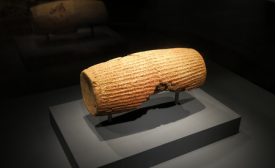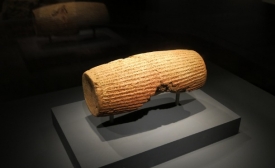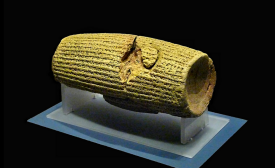cyrus cylinder
It is always heartening to hear discussion of historical artifacts not strictly as museum pieces but as instruments that can transmit other cultural messages and interpretations of identity. The Cyrus Cylinder is an example of ancient cultural heritage that resonates with new meanings today. Inspired by the blogs by Jay Wang and Naomi Leight my interest was sparked on this subject.

It is always heartening to hear discussion of historical artifacts not strictly as museum pieces but as instruments that can transmit other cultural messages and interpretations of identity. The Cyrus Cylinder is an example of ancient cultural heritage that resonates with new meanings today. Inspired by the blogs by Jay Wang and Naomi Leight my interest was sparked on this subject.
This week at CPD, we hosted Dr. Timothy Potts, the director of the J. Paul Getty Museum, who discussed the Cyrus Cylinder as a cultural icon and museums as vehicles for promoting global dialogue. Potts shared with us the history and meaning of the Cylinder; a clay foundation deposit no larger than a loaf of bread inscribed following Cyrus the Great’s incorporation of Babylon into the Persian Empire in 539 BCE.

This week at CPD, we hosted Dr. Timothy Potts, the director of the J. Paul Getty Museum, who discussed the Cyrus Cylinder as a cultural icon and museums as vehicles for promoting global dialogue.

The Cyrus Cylinder, a 2,500-year-old object discovered in ancient Babylon, is considered by many to be the first declaration of human rights. This unique artifact, part of the British Museum collection, continues to excite the imagination of different peoples from around the world.
Gil J. Stein, the Director of the Oriental Institute and Professor of Near Eastern Archaeology in the department of Near Eastern Languages and Civilizations at the University of Chicago, who is in Iran now has called on Abdolmajid Arfayee, the translator of the Cyrus Cylinder, to translate the Achaemenid tablets which have been confiscated by a court in the US.
The Cyrus Cylinder, a small clay object dated from the sixth century B.C.E. and covered in Babylonian cuneiform script of an imperial decree by King Cyrus of Persia, is considered by many to be a powerful symbol of cultural and religious tolerance. Its international touring exhibition, spearheaded by the British Museum, has drawn broad global attention and is, by most measures, a resounding success.

The Cyrus Cylinder, a small clay object dated from the sixth century B.C.E. and covered in Babylonian cuneiform script of an imperial decree by King Cyrus of Persia, is considered by many to be a powerful symbol of cultural and religious tolerance. Its international touring exhibition, spearheaded by the British Museum, has drawn broad global attention and is, by most measures, a resounding success.







